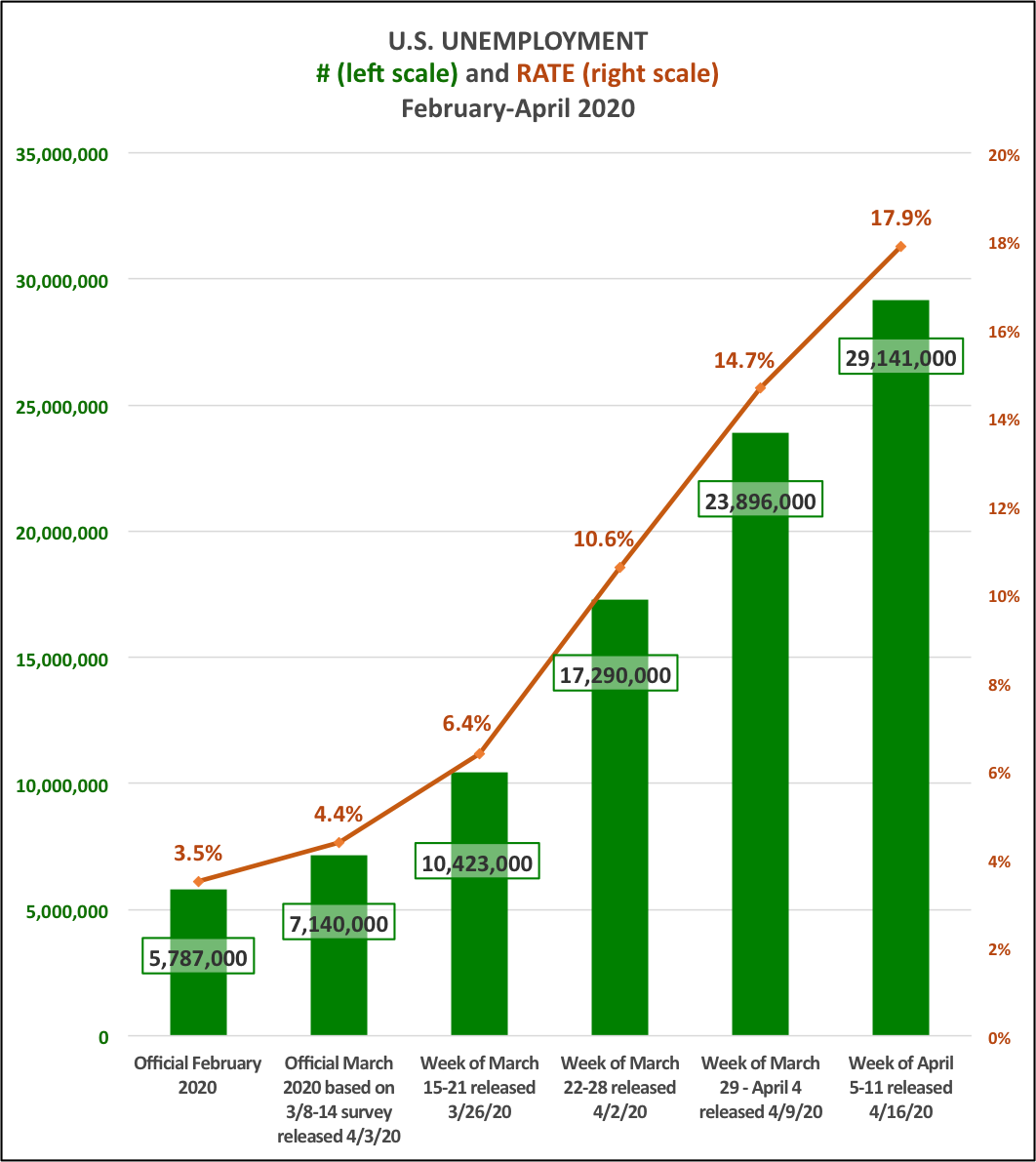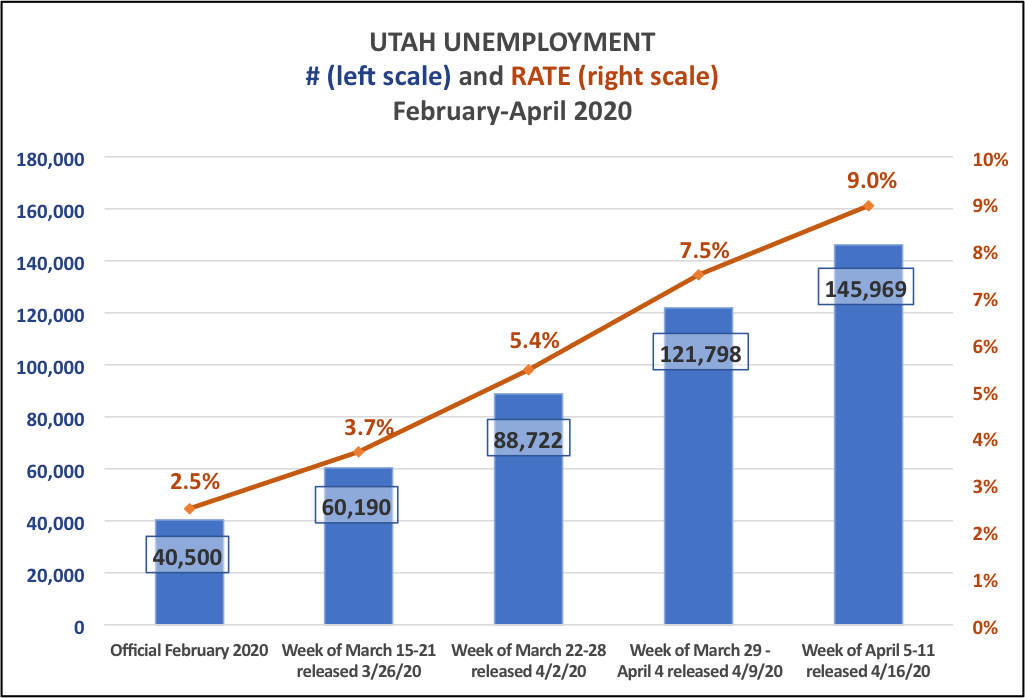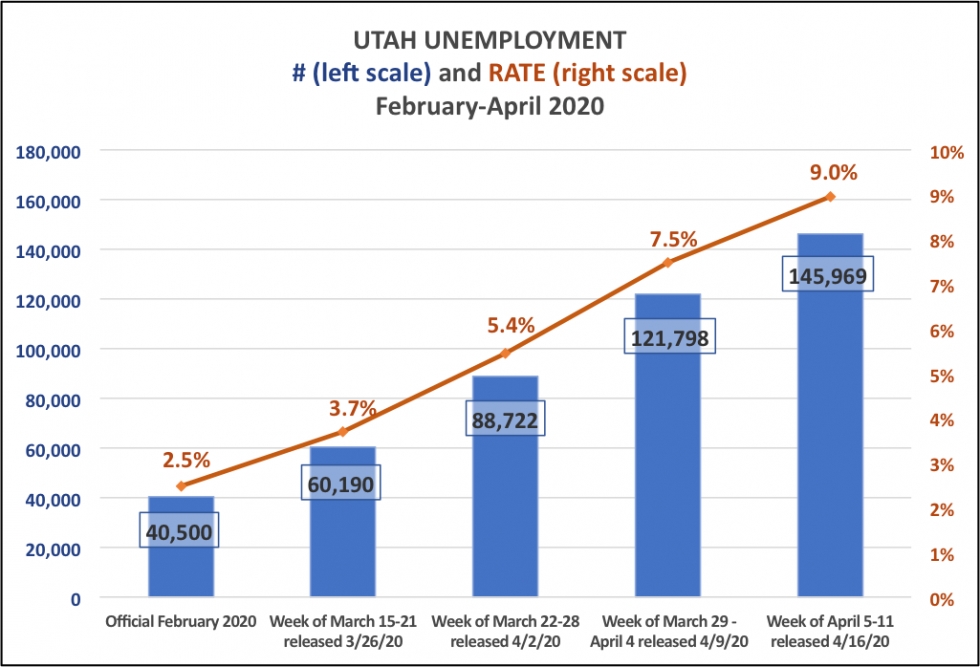Utah’s Unemployment Rate Now Exceeds Its 2010 “Great Recession” Peak
By Matthew Gordon, Connor Hill, and Matthew Weinstein
April 17, 2020
Weekly unemployment insurance filings have set new records over the last month as the Coronavirus Recession takes its toll. But what exactly is the current unemployment rate? Official figures at the state level are published monthly, with the March figures at the state level due to be published today, Friday, April 17, based on a survey conducted in early March, before social distancing and stay-at-home orders went into effect. That means we will have to wait another month to learn what the rate was a week ago according to the official figures.
But economists have devised a method to approximate the most current unemployment rate based on weekly unemployment insurance filing data. This method is inexact because it requires using the last official figures from February for the size of the state labor force, even though the labor force is always changing. For example, the labor force generally grows over time with population, especially here in Utah with our population growing rapidly due mostly to our high birth rate. It is also true that the labor force tends to shrink during recessions as many unemployed give up looking for work and often even give up on trying to apply for unemployment insurance (owing to the fact that most of the unemployed do not qualify for unemployment insurance in the typical recession, though for this one the federal government has broadened eligibility considerably through the CARES Act). This methodology also requires assuming that everyone who filed for unemployment insurance 3-4 weeks ago is still unemployed, even though we know that some people have taken new jobs now with warehouse retailers and grocery delivery companies that have seen demand rise sharply in the last month.
Nonetheless, given the public’s curiosity for the latest data, this method has proven to be popular. For example, yesterday Fortune magazine used this method to estimate that the U.S. unemployment rate is now 17.9% based on weekly unemployment insurance filing data released the same day. We created the chart below using this method to illustrate the national trend:

The figures on the left side of the chart labeled as “Official February 2020” and “Official March 2020...” are the official national unemployment figures released in March and April, respectively, by the Bureau of Labor Statistics at the U.S. Department of Labor. The four sets of figures on the right side of the chart use the methodology described above to illustrate how the national unemployment rate has risen since early March. The most recent figures on the right side of the chart are the same as the ones published Thursday in Fortune magazine as referenced above.
What would the state unemployment rate be if we applied this methodology to Utah? To calculate this figure, we added up the weekly unemployment insurance filings in Utah and divided by the size of the workforce according to the latest official figures published last month for February. The chart below illustrates these figures:

The first set of figures on the left side of the chart are the official February data released in March. The four sets of figures to the right are based on the last four sets of weekly unemployment filings, up to and including the figures released on Thursday, April 16.
The Bad News: Utah’s current unemployment rate of 9.0% (based on the weekly unemployment insurance filings released April 16, 2020) is higher even than the highest unemployment rate Utah experienced during the Great Recession, when we peaked at 8.4% in the early months of 2010.
The Good News: While the national unemployment rate has risen since February by 14.4 percentage points to 17.9%, here in Utah it is up by “only” 6.5 percentage points to a level of 9%, about half the national unemployment rate. Thus, Utah is doing much better than the nation as a whole at preserving employment in spite of extraordinarily trying circumstances.
One of the major implications of job loss is loss of employer-provided health insurance. This week the Economic Policy Institute estimated that about 50,000 Utahns have lost their employer-sponsored health insurance as a result of COVID-related layoffs, making public health insurance options like Medicaid all the more important at this time.
Next Friday Voices for Utah Children's economic analysis team will release new estimates for the Coronavirus Recession's impact on state GDP, tax revenues, and houshold incomes to update the figures released two weeks ago. The 4/1/20 figures were based on applying national projections to Utah. Next week's estimates will reflect what we now know about how Utah's economic performance compares to the nation in the current circumstances.
About the authors:
Matthew Gordon is a sophomore University of Utah undergraduate Economics and Mathematics double-major currently interning with Voices for Utah Children.
Connor Hill is a University of Utah Economics Master’s degree student who received his Bachelor’s degrees in Economics and Political Science from the U in 2019. He is also currently interning with Voices for Utah Children.
Matthew Weinstein, MPP, is state priorities partnership director on the staff of Voices for Utah Children, where his duties include overseeing the organization’s economic analysis program.






